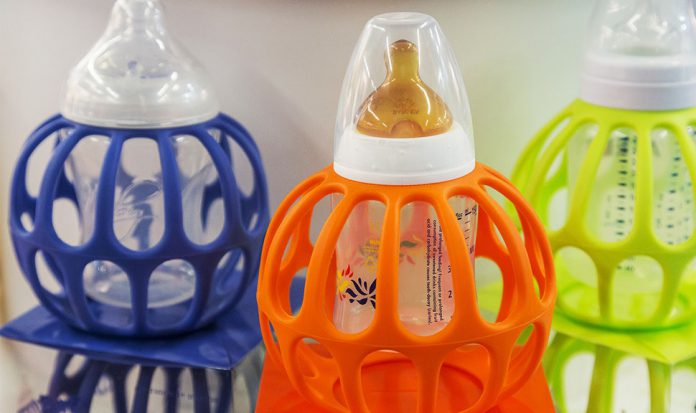During your baby’s first year of life, his immune system is still young and developing and not yet ready to battle the common bacterias and viruses adults get every day. In their tender years, they are most susceptible to diseases and illnesses. One way to prevent unwanted sickness among babies is to make sure their feeding bottles are sterilized properly. If bottles are not cleaned and prepared well, your child will be exposed to bacteria that could lead to illnesses.
Fortunately, the best way to sterilize baby bottles isn’t as complicated as it sounds. This simple guide will help new parents get familiar with the proper way of ensuring feeding bottles are clean and bacteria-free.
Always Sterilize New Baby Bottles
New parents may tend to think that brand new baby bottles don’t need cleaning anymore. Unfortunately, brand new doesn’t always mean germ-free. After opening its package, sterilize the bottle immediately. This will clear the bottles and nipples of bacteria that may have accumulated while the bottle was on display.
How Often Should I Sterilize?
Contrary to rumors, you don’t always have to sterilize after each use. In fact, you can stick to a once-a-week sterilizing routine. However, if you want to ensure that bacteria is totally eliminated, you can sterilize baby bottles once a day.
Until When Do I Sterilize?
It is recommended that bottles used by kids below one year old should be frequently sterilized. By the time they reach the age of one — when their bodies are already able to fight off bacteria — you can lessen the frequency of sterilizing bottles.
What About BPA?
BPA is an awful chemical that is found in plastic. When heated, it has a tendency to leach into your baby’s milk. BPA has been consistently linked to developmental problems in children. Since sterilizing always comes with heat, it’s best to look for bottles that are BPA free. If you’re concerned with BPA, you can opt for glass baby bottles over plastic ones.
Sterilizing Bottles by Boiling
Clean the bottles, teats, caps, and utensils thoroughly before boiling. It may sound like a no-brainer but some of us may have the tendency to think that “cleaning” simply means putting the bottles under running water and then that’s it, it’s ready for sterilizing. Cleaning here means washing the bottles in hot, soapy water using a mild dishwashing liquid to remove milk residues and oil from the bottles to make it squeaky clean.
Use a large saucepan with enough room to spare if a sterilizer is not available. A saucepan has been the sterilizer of choice before the easy-does-it sterilizers were born. The saucepan should be big enough so that the bottles can freely jostle against each other during boiling.
Add enough water to cover the bottles: How much is enough? When there is no space for air bubbles in the bottle, the water is enough. Putting less water will compromise sterilization while adding too much water is not economical.
Bring the water to a boil and let boil for 5 minutes. Let the water cool down after boiling.
Disinfect hands by washing before handling the feeding bottles and equipment. The work area should also be clean and disinfected.
Store dry feeding bottles in a clean container in the fridge when not used immediately.
Re-boil the feeding bottles if they are not used within 24 hours.
Sterilizing by Electric Sterilizers
Microwave or electric sterilizers use steam to kill harmful bacteria Always follow the manufacturer’s instructions on how to operate the sterilizer. As in boiling, thorough cleaning of the feeding bottles and equipment is a must. Remember to put the bottles inside the sterilizer with the bottom up.
Follow manufacturer’s instruction on how much water is needed and how to turn it on. The sterilizer has a thermostat and a timer that will operate on its own.
Unlike in the boiling method, the bottles can stay inside the sterilizer until they are needed. Check with the manufacturer on how long the feeding bottles can stay in the sterilizer without being re-sterilized.
Sterilizing by Chemicals
Liquid and tablet disinfectant solutions that are diluted with water is the chemical way of disinfecting a baby’s feeding bottle and equipment. Clean the bottles, teats, caps, and equipment before immersing in the chemical solution. Follow the manufacturer’s instruction in diluting the chemicals.
Ensure that the feeding bottles are completely covered by the chemical solution with no air bubbles. Leave the bottles in the chemical solution for a time based on the manufacturer’s specification on time. They usually recommend about 30 minutes.
Do not rinse off the feeding bottles after being soaked in the solution. Just drain them before using. Rinsing removes the efficacy of the chemicals. Throw the solution after 24 hours and wash the sterilizing container before the next use.
Sterilizing your baby’s bottles brings peace of mind — you know you have reduced the risk of exposing your kid to harmful bacteria. Fortunately, there are now various ways of sterilizing that fits different lifestyles. Share this with new parents to help them know the proper way of cleaning and sterilizing bottles so they can always keep their new babe healthy.
Join our MomCenter Community on our Facebook page and Facebook group for more insights on motherhood and parenting.





